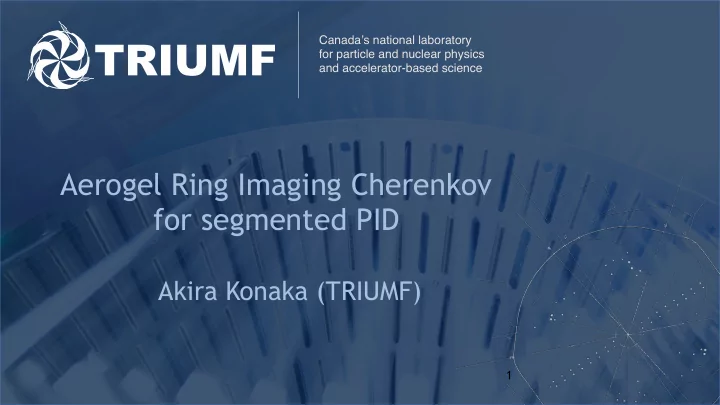

Canada’s national laboratory for particle and nuclear physics and accelerator-based science Aerogel Ring Imaging Cherenkov for segmented PID Akira Konaka (TRIUMF) 1
Hadron production measurement with hybrid emulsion • Add secondary particle detectors for hadron production - Hadron production for 30GeV proton beam - Hadron interactions below 10GeV/c (for T2K secondary interaction) 2
Emulsion track selections • Tagging of emulsion tracks - Select emulsion track that matches with the silicon strip detector hits • selection of emulsion tracks that happens at the event time provided by silicon - secondary PID: ~1mm hit accuracy with Aerogel Rich • in principle, downstream emulsion tracks can be selected with Aerogel Rich • want silicon tracker in the central region with dense tracks 3
Particle Identification by Aerogel-RICH (Belle2) • Aerogel ring imaging Cherenkov - π / K / p separation in 1-5 GeV/c • more flexible than threshold Cherenkov • Momentum range extended by lower index aerogel - Multi-track (multi-ring) capability for secondaries - Time of flight with the central hit (PMT glass Cherenkov) Iijima et. al. NIMA548(2005)383 PMT glass Cherenkov 4
Rough estimation of PID Belle2 achieves 7 σ π /K separation at 5GeV/c for n~1.05 Lower index helps for higher momentum for each photoelectron discrimination power 5
Particle identification • Aerogel ring imaging Cherenkov hardware - Aerogel • 10cm x 10cm x 1cm of n=1.01, 1.015, 1.03 purchased from JFCC • Collaboration with Chiba university (Kawai) for n=1.0026-1.3 Aerogel - JFCC, Nobosivilsk, NASA and Chiba are the only producers - $4k per batch (cost for student labour) covered by US-Japan funds » one batch can make up to eight 10cm x 10cm x 2cm plates » received n=1.02 sample with 10cm x 10cm x 2cm in size - PMT: multi-anode(MA) PMT (~$3k/piece and we need 9) • we have one MA-PMT (8x8=64 6mmx6mm pads) : ~$3000/PMT - No magnetic field: no need for Belle2 like Hybrid Avalanche Photodetector (~$10,000/PMT) - Electronics • One TRB3 board purchased from GSI: FPGA based TDC - A 2600EUR card can take up to 192 channels (3 MA-PMT): one ordered • Electron ID will be done by the lead glass counter (at Fermilab) 6
Cosmic ray test of Aerogel (Khalid Gameil) trigger scintillator Aerogel single photoelectron 2-inch PMT peak PMT only PMT+Aerogel PMT+Aerogel pe (glass) pe 2cm, n=1.03 2cm, n=1.015 pe N=12pe N=20pe N=16pe (N aerogel =8pe) (N aerogel =4pe) 7
Photoelectron yield study with a cosmic ray test stand • N pe = α x d x (1-1/n 2 ) for β =1 particles - Belle2 measurement: • 4cm n=1.05 aerogel with PMT coverage of 48%: N pe =11.4 • α = N pe / d / (1-1/1.05 2 ) /0.48 = 63.5 • Expected N pe from Belle2 compared with cosmic ray test - assuming that the quantum efficiency is the same - Observed Cherenkov light yields are consistent assuming PMT glass is 3mm thick Material thickness(d) index(n) phoelectons(N pe ) expected (*) 0.3cm 1.54 12 11.0 PMT glass Lucite 2cm 1.5 72 70.6 2cm 1.030 8 7.3 Aerogel 015 Aerogel 030 2cm 1.015 4 3.7 8
Summary • Aerogel Rich provides compact multi-track PID - Well established technology by Belle2 for up to p=5GeV/c - Lower index of refraction extends the momentum coverage • Aerogel R&D under way with Chiba university group • Cosmic ray test confirms the expected light yield: - N=4pe even for n=1.015 and 2cm-thick Aerogel • Started an evaluation of FPGA based TDC from GSI - Used for Rich with the same multi-anode PMT we use - Economical: 2600EUR for 192 channels • One PMT prototype due to limited budge/human resource 9
Recommend
More recommend